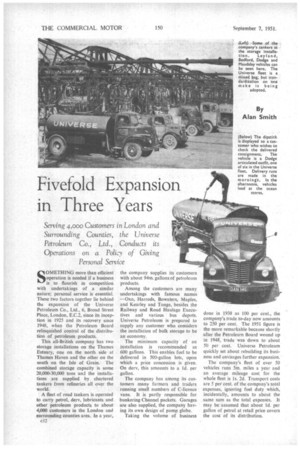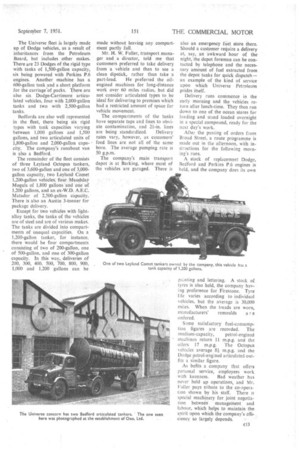Fivefold Expansion in Three Years
Page 48

Page 51

If you've noticed an error in this article please click here to report it so we can fix it.
Serving 4,000 Customers in London and Surrounding Counties, the Universe Petroleum Co.) Ltd., Conducts its Operations on a Policy of Giving
By Alan Smith
Personal Service
SOMETHING more than efficient operation is needed if a business is to flourish in competition with undertakings of a similar nature; personal service is essential. These two factors together lie behind the expansion of the Universe Petroleum Co., Ltd., 6, Broad Street Place, London, E.C.2, since its inception in 1925 and its recovery since 1948, when the Petroleum Board relinquished control of the distribution of petroleum products.
This all-British company has two storage installations on the Thames Estuary, one on the north side at Thames Haven and the other on the south on the Isle of Grain. The combined storage capacity is some 20,000-30,000 tons and the installations are supplied by chartered tankers from refineries all over the world.
A fleet of road tankers is operated to carry petrol, derv, lubricants and other petroleum products to about 4,000 customers in the London and surrounding counties area. In a year, c 1 2 the company supplies its customers with about 94m. gallons of petroleum products.
Among the customers are many undertakings with famous names —Oxo, Harrods, Bowaters, Maples, and Kearley and Tonge, besides the Railway and Road Haulage Executives and various bus depots. Universe Petroleum is prepared to supply any customer who considers the installation of bulk storage to be an economy.
• The minimum capacity of an installation is recommended as 600 gallons. This enables fuel to be delivered in 500-gallon lots, upon which a price concession is given. On derv, this amounts to a Id. per gallon.
The company has among its customers many farmers and traders running small numbers of C-licence vans. It is partly responsible for bunkering Channel packets. Garages are also supplied, the company having its own design of pump globe.
Taking the volume of business done in 1938 as 100 per cent., the company's trade to-day now amounts to 250 per cent. The 1951 figure is the more remarkable because shortly after the Petroleum Board wound up in 1948, trade was down to about 50 per cent. Universe Petroleum quickly set about rebuilding its business and envisages further expansion.'
The company's fleet of over 50 vehicles runs 5m. miles a year and an average mileage cost for the whole fleet is Is. 2d, Transport costs are 5 per cent. of the company's total expenses, ignoring fuel duty which, incidentally, amounts to about the same sum as the total expenses. It may be assumed that about id. per gallon of petrol at retail price covers the cost of its distribution.
The Universe fleet is largely made up of Dodge vehicles, as a result of inheritances from the Petroleum Board, but includes other makes. There are 23 Dodges of the rigid type with tanks of 1,500-gallon capacity, six being powered with Perkins P.6 engines. Another machine has a (300-gallon tank and a short platform for the carriage'of packs. There are also six Dodge-Carrimore articulated vehicles, four with 2,000-gallon tanks and two with 2,500-gallon tanks.
Bedfords are also well represented in the fleet, there being six rigid types with tank capacities varying between 1,000 gallons and 1,500 gallons, and two articulated units of 1,800-gallon and 2,000-gallon Capacity. The company's runabout van is also a Bedford.
The remainder of the fleet consists of three Leyland Octopus tankers, two of 3,600-gallon and one of 3;000gallon capacity, two Leyland Comet 1,200-gallon vehicles, four. Maudslay Moguls of 1,800 gallons and 'oiie.of 1,200 gallons, and an ex-W.D. A.E.C. Matador of 2,500-gallon capacity. There is also an Austin 3-tonner for package delivery.
Except for two vehicles with lightalloy tanks, the tanks of the vehicles are of steel and are of various makes. The tanks are divided into compartments of unequal capacities. On a 1,200-gallon tanker, for instance, there would be four compartments consisting of two of 200-gallon, one of 500-gallon, and one of 300-gallon capacity. In this way, deliveries of 200, 300, 400, 500, 700, 800, 900, 1,000 and 1,200 gallons can be made without leaving any compartment partly full.
Mr. H. W. Fuller, transport manager and a director, told me that customers preferred to take delivery from a 'vehicle and then to see a clean dipstick, rather than take a
part-load. He preferred the oilerigined machines for long-distance work over 60 miles radius, but did not consider articulated types to be ideal for delivering to premises which had a restricted amount of space for vehicle movement.
The compartments of the tanks have separate taps and lines to obviate contamination, and 21-in. lines
are being standardized. Delivery rates vary, however, as customers' feed lines are not all of the same bore. .The average pumping rate is 50 g.p.m.
The company's main transport depot is at Barking, where most of the vehicles are garaged. There is
also an emergency •fUel store there. Should a customer require a delivery at, say, an awkward hour of the night, the depot foreman can be contacted by telephone and the necessary amount of fuel extracted from the depot tanks for quick dispatch— an example of the kind of service upon which Universe Petroleum prides itself.
Delivery runs commence in the early morning and the vehicles return after lunch-time. They then run down to one of the ocean stores for loading and stand loaded overnight in a special compound, ready for the next day's work.
After the passing of orders from Broad Street, a route. programme is made out in the afternoon, with instructions for the following morning's runs.
A stock of replacement Dodge, Bedford and Perkins P.6 engines is held, and the company does its own painting and lettering. A stock of tyres is also held, the company having preference for Firestone. Tyre life varies according to individual vehicles, but the aVerage is 30,000 miles. When the treads are worn, manufacturers' remoulds a r e ordered.
Sr,nne satisfactory fuel-consumption figures are recorded. The
medium-capacity, petrol-engin ed machines return It m.p.g. and the oilers 17 m.p.g. The Octopus vehicles average 81 m.p.g. and the Dodge petrol-engined articulated outfits a similar figure.
As befits a company that offers personal service, employees work with keenness. Bad weather has never held up operations, and Mr. Fuller pays tribute to the co-operation shown by his staff. There is special machinery for joint negotiation between management and labour, which helps -to maintain the spirit upon which the company's efficiency so 'largely depends.
























































































